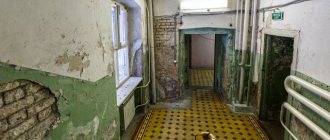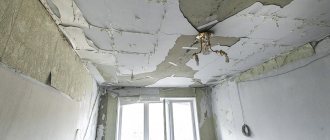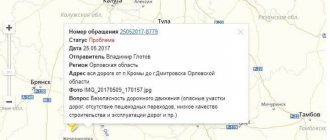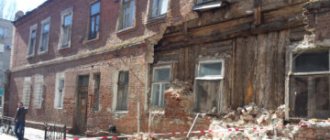Necessary conditions for resettlement
A prerequisite for resettlement is the recognition of the house as unsafe. This is carried out on the basis of an act of the local government body.
In other words, in case of high wear and tear of the house, by decision of the local administration, the house may be considered dangerous for habitation. In this case, tenants (social tenants and owners) have the right to be provided with alternative living space.
Expert opinion
Stanislav Evseev
Lawyer. Experience 12 years. Specialization: civil, family, inheritance law.
There is no general procedure for recognizing a house as unsafe on the territory of the Russian Federation. The exact algorithm is established by regional legislation.
Therefore, to obtain accurate information about your situation, it is necessary to obtain legal advice. A specialist will study your problem and give advice based on the information received.
Citizens often confuse the concepts of dilapidated and emergency. It is necessary to clarify that a house that is subject to major repairs is considered dilapidated. And emergency - subject to demolition, since further residence in it is unsafe.
Therefore, if a house is declared dilapidated, citizens may be provided with alternative housing. However, only temporarily. For the period of major renovation of residential premises.
Unfortunately, this measure is not a panacea. When carrying out major repairs, the law does not provide funds for replacing beams and floors. Therefore, repair actions often do not give the desired result.
Since 2021, a new law on the resettlement of emergency houses has come into force. Let's take a closer look.
Urgent elimination of emergency
91K 1 3 min.
The authorities are ready to begin a new stage of the program to eliminate dilapidated housing. Without waiting for the completion of the resettlement of houses declared unsafe on January 1, 2021, Vladimir Putin on Tuesday proposed including housing declared unsafe by the beginning of this year in the program. We are talking about 11 million square meters. m - it is planned to allocate 45 billion rubles for the liquidation of this fund in 2022–2024. Experts note the severity of the problem and the fact that to solve it it is necessary to increase the volume of private funds attracted to the program.
The new stage of the program for the resettlement of emergency housing may be broader than what has already been implemented, if it is possible to attract private money to it
Photo: Yuri Martyanov, Kommersant / buy photo
The new stage of the program for the resettlement of emergency housing may be broader than what has already been implemented, if it is possible to attract private money to it
Photo: Yuri Martyanov, Kommersant / buy photo
The program for eliminating the emergency housing stock is planned to be significantly expanded - as Vladimir Putin announced at the United Russia congress on Tuesday, it is now planned to resettle housing recognized as emergency by January 1, 2021. “As a first step, I propose to allocate 45 billion rubles for these purposes. from the federal budget,” the president announced, asking the congress participants (apparently assuming that they would all fill the future State Duma) to support this initiative when considering the budget for 2022–2024.
We are talking about a fairly large volume of emergency housing - more than 11 million square meters. m. The president did not indicate the timing of resettlement. However, the Ministry of Construction has already thought about this - in the draft of the updated housing state program, the department proposes to take into account the resettlement of 16.2 million square meters in 2025–2030. m, recognized as emergency after January 1, 2017. This will not allow us to get rid of such a fund - at the beginning of the year, the department estimated that by 2030 30.2 million square meters could be formed. m of emergency housing, the resettlement of which will require 2.3 trillion rubles.
Let us explain that this massif is growing due to the fact that the growth rate of the uninhabitable stock is quite high (about 2 million sq. m per year) and sometimes exceeds the rate of resettlement. Currently, the program for 2019–2024 includes almost 9 million square meters. m - a total of 507 billion rubles were announced for their resettlement, of which 431 billion rubles. These are federal funds, the rest are regional. The current program is actually a continuation of the 2014–2018 program (11 million square meters each recognized as emergency by 2012).
The reason for the current expansion of the program until it is fully implemented can apparently be considered the high pace of its implementation: as Deputy Prime Minister Marat Khusnullin previously reported, the program can be completed a year earlier, in 2023.
They were also talking about ahead of schedule on Tuesday - according to Vladimir Putin, nine regions will complete the program by the end of this year. According to the Housing and Communal Services Fund, in 2019–2021, 203.7 thousand people out of 3.4 million square meters were resettled. m "emergency warning lights" - targets were exceeded by 11% and 3%, respectively.
It should be noted that several factors contributed to this dynamics: rather low target indicators in the first years of the program’s implementation (0.66–1.33 million sq. m in 2019–2020 versus 2.96–2.68 million sq. m in 2014–2020); 2015), as well as financial incentive measures. So, a year ago, the White House “added” an additional 50 billion rubles to 2021. from the funds allocated for 2022 - for more rapid resettlement of more than 1 million square meters. m "emergency lights". A week ago, 13.1 billion rubles were allocated from funds - this will speed up the resettlement of 417 thousand square meters. m.
As Nadezhda Kosareva, president of the Institute of Urban Economics Foundation, notes, some regions, having completed the current program, are already moving on to the resettlement of houses recognized as unsafe after January 1, 2017. At the same time, she notes, the constituent entities of the Russian Federation “behave according to their capabilities - they recognize houses that really require resettlement as unsafe, so as not to increase the volume of obligations that require budget money.”
Vice President of the Center for Strategic Research Tatyana Karavaeva adds that even when previously planned values are reached, the problem is still acute for many Russian cities.
To solve it, the expert believes, the regions need to work on the issue of attracting additional funds. “For example, in large cities it is important to attract private investors; for remote settlements from which the population leaves, it is possible to use subsidies for the purchase of housing in other regions,” says Ms. Karavaeva.
According to Nadezhda Kosareva, there are opportunities to attract private funds: in addition to the resettlement of emergency housing entirely at the expense of budget funds, the Housing and Communal Services Fund can allocate funds for the resettlement of citizens from the emergency fund within the framework of integrated territorial development projects (CTD). So, she explains, if the project is implemented by a private developer who wins the competition, then the fund will compensate up to 25% of the costs of resettling the emergency workers (in some cases - up to 100%, as in situations where the project is carried out by a special legal entity created by the region). “This mechanism is completely new—the Housing and Communal Services Fund has so far received only the first applications—but I hope that it will be a serious lever for accelerating the implementation of the program and increasing its financing,” says Ms. Kosareva.
Evgenia Kryuchkova
Procedure and rules for relocation from dilapidated and emergency housing
As part of the implementation of Decree of the President of the Russian Federation of 2021 No. 204, the national project “Housing and the Urban Environment” is being implemented. Implementation is planned for the period from 2021 to 2024.
During this period it is planned:
- relocate almost 530.9 thousand people from housing stock unsuitable for citizens;
- to resettle more than 9.4 thousand square meters of housing that was considered unsafe until 2021.
More than 507.1 billion rubles are allocated for the implementation of the project. Funds include regional co-financing. This means that almost 1/6 of the funding comes from regional budgets.
Each house that is recognized as unsafe is included in the regional program. Next, the information is transferred to the federal register.
Provision of living space is carried out on a priority basis. That is, the sooner the house was included in the program, the sooner the residents will receive alternative living space.
The exception is houses that are moved out of turn. This is possible if the technical condition of the premises suggests imminent destruction.
The draft Resolution of the Government of the Russian Federation “On Amendments to the Resolution of the Government of the Russian Federation No. 278 is posted on the portal of draft regulatory legal acts .
Photo: www.news.sarbc.ru
Let us recall that by Decree of the Government of the Russian Federation No. 1385 of August 23, 2021, changes were made to paragraphs 1 and 2 of Decree of the Government of the Russian Federation No. 278 of March 16, 2019, according to which the indication of the specific amount of subsidies allocated to increase the limits for the provision of financial support was excluded subjects of the Russian Federation, broken down by year.
The Fund provides financial support to a constituent entity of the Russian Federation for the resettlement of citizens from emergency housing stock in excess of the limit established for this subject for the current year, but not in excess of the calculated limit of funds for resettlement in the coming years until 2024 inclusive.
Such above-limit financial support may be provided subject to:
•
completion of the regional targeted program for the resettlement of citizens from emergency housing stock, approved before January 1, 2019, the absence of unfulfilled obligations to return funds from the Fund on the grounds provided for by this federal law and the agreement concluded between the Fund and a constituent entity of the Russian Federation.
•
acceptance by a subject of the Russian Federation of an obligation to complete early all or part of the measures for relocating citizens from emergency housing stock, provided for by the regional targeted program for the resettlement of citizens from emergency housing stock, recognized as such before January 1, 2021, in proportion to the amount of excess financial support provided.
Photo: www.sarbc.ru
In the new version of Resolution No. 278, the entire amount of subsidies received by the Fund is subject to distribution to increase the limits for the provision of financial support among all constituent entities of the Russian Federation.
The draft Resolution introduces paragraph 6(2) that if the size of the subsidy in the form of the property contribution of the Russian Federation increases in the current year by reducing the size of subsidies for future years, such subsidies are not used to increase the limits for the provision of financial support in the current year, but are used to provide above-limit financial support.
Photo: www.msk.mosreg.ru
Let us remind you that in accordance with the order of the Government of the Russian Federation No. 2301-r dated August 23, 2021, the Fund in 2021 is allocated subsidies in the amount of 13,141,958.7 thousand rubles from the reserve fund of the Government of the Russian Federation. in the form of a property contribution of the Russian Federation to ensure a sustainable reduction of uninhabitable housing stock within the framework of a federal project.
Thus, if a new version of Resolution No. 278 is adopted, the entire amount of subsidies received by the Fund in 2021 is subject to distribution to increase the limits for the provision of financial support among all constituent entities of the Russian Federation in 2021.
Photo: www.protarif.info
On September 13, 2021, following the results of the second stage of the 20th Congress of United Russia, held on August 24, 2021, President Vladimir Putin instructed the Government of the Russian Federation to allocate 45 billion rubles from the federal budget in 2022. for the implementation by constituent entities of the Russian Federation of programs for the liquidation of housing stock recognized as emergency as of 01/01/2021.
The independent anti-corruption examination of the document will last until September 16, 2021
Other publications on the topic:
The net profit of Bank DOM.RF for the year increased more than fourfold - to 7 billion rubles.
How will the goals of providing subsidies to the property of the Fund for the Protection of Shareholders be clarified in 2021-2023?
What new statutory powers will the Fund for the Protection of Shareholders receive?
The powers of the Shareholders Protection Fund have been expanded
A new fund with expanded powers is being created in Russia
Marat Khusnullin: By the end of the year we will merge the Fund for the Protection of Shareholders with the Housing and Communal Services Fund
How the powers of the Fund for the Protection of Shareholders have been expanded
How the powers of the Fund for the Protection of Shareholders will be expanded
A law has been adopted expanding the rights of the Fund for the Protection of Shareholders
The government will allocate 50 billion rubles. for resettlement of over 1.1 million square meters. m of emergency housing
Algorithm of actions
If you live in a house with high wear and tear, but it has not yet been recognized as unsafe, then the process must be initiated. Apartment owners and tenants of apartments under a social tenancy agreement have the right to appeal to local government bodies regarding the recognition of a house as unsafe.
The law does not equate commercial tenants and citizens living in service housing with owners. Therefore, it does not give them the right of appeal.
Procedure for relocating an emergency house:
- The house is officially recognized as unsafe.
- Drawing up a relocation agreement.
- Getting new housing.
The resettlement procedure takes a long time. In 2021, new housing was not provided to everyone who was put on the waiting list before 01/01/2017.
Therefore, waiting periods can exceed 10 years. However, even during this period, new housing will not be obtained if active action is not taken.
So let's start with the design.
Recognition of a house as unsafe
A house is not officially considered unsafe until a corresponding resolution has been issued by a local government body. The document is issued based on the decision of the interdepartmental commission.
Such a commission should be organized in each municipality. You can submit an application directly to the Housing Committee under the administration, or through the MFC.
The application must be submitted in writing. It would be advisable to make a collective appeal from citizens. You can also involve the management company or HOA in this issue.
| No. | Procedure for contacting the authorized body |
| 1 | Preparation of documents on the technical condition of the house |
| 2 | Submitting an application to the authorized body |
| 3 | Holding a meeting of the interdepartmental commission |
| 4 | Site visit by commission members |
| 5 | Making a decision (positive or negative) |
If a negative decision is made, it is necessary to challenge it in court. The plaintiff in the process can be any owner of an apartment from the disputed building or a tenant.
At the same time, it is necessary to file complaints with the prosecutor's office. The purpose of the complaint is to bring to justice officials who violate the right of citizens to safe housing.
One of the relevant types of evidence is the result of an examination. The specialist will assess the degree of wear and issue an appropriate conclusion.
Drawing up a relocation agreement
The queue for relocation must be monitored independently. In 2021, information is freely available on the Housing and Communal Services Reform website.
On the site you need to find your region and follow the link. Then you need to choose your area of residence. After which a list of emergency houses in the area becomes available, indicating contracts for relocation.
How do I know if a house is included in the relocation program?
Programs for the resettlement of citizens from dilapidated housing stock in all regions of the Russian Federation are posted in the section “Resettlement of dilapidated housing/Programs of constituent entities of the Russian Federation” on the website www.reformagkh.ru.
The website contains information on the resettlement of apartment buildings recognized as unsafe before January 1, 2021. The program is designed for the period until September 1, 2025.
The deadline for relocating each house is established in the regional program of the corresponding constituent entity of the Russian Federation. To receive an extract, you must indicate the address of the house in the section and click the “printer” button to generate a request for an extract from the register of dilapidated houses.
What to do if the house is declared unsafe, but is not in the relocation program?
What kind of bill on all-Russian renovation? More details
If a house is recognized as unsafe before January 1, 2021, it must be included in the resettlement program financed with the participation of the Housing and Communal Services Fund. If for some reason such a house is not included in the program, you should file an application or complaint with the regional authorities or the Housing and Communal Services Fund.
Getting new housing
From 2021, the procedure for obtaining new housing has been changed. However, citizens who did not receive an apartment when registering before 01/01/2017 have the right to be provided with housing under the old legislation.
For the employer
The new law did not change much the situation of citizens who used an apartment under a social tenancy agreement. As before, the tenant has the right to housing of similar size.
If a family needs to increase its space, it is necessary to first register as a family in need of improved living conditions.
As before, the tenant is required to pay monthly rent for the apartment if he does not have benefits.
For the owner
Under the old legislation, the owner of an apartment in disrepair has the right to receive residential premises free of charge. The apartment must be fully equipped (have water supply, sewerage, central heating).
Important! Requirements for improvement are relevant if the locality has a system of central provision of utilities.
Conditions of the old resettlement program:
- A prerequisite is that the area of the emergency and new apartment corresponds. The owner has the right to receive housing of equal size.
- If the suitable apartment has a larger area, the owner is obliged to pay the difference.
- Providing new housing under the resettlement program is not a program to improve living conditions. Therefore, you can only request more rooms or space for an additional fee.
- In case of refusal to obtain housing, a citizen has the right to compensation. It is calculated based on the residual value of the property and transferred to the owner’s personal account.
- If the apartment belongs to several owners on the basis of shared ownership, then compensation is transferred to their personal accounts, in accordance with their shares in ownership.
Let's look at how owners of dilapidated houses are resettled in accordance with the housing and communal services reform.
The reform significantly changed the procedure for property owners to obtain housing:
- The owner has the right to receive housing.
- His emergency apartment is assessed based on its residual value.
- This amount is subtracted from the cost of the new apartment
- He must pay the rest himself.
If the owner does not have funds for additional payment, he receives compensation by transfer to his account. And he receives housing under a social rental agreement.
The law establishes a list of citizens who will not have to pay rent for social rent:
- pensioners;
- disabled people;
- large families.
Other categories of citizens are required to pay a monthly fee based on the average market rent for the area. In case of non-payment within 6 months, tenants may be forcibly evicted.
Important! If the owner owns another residential premises, then he does not have the right to receive a new apartment. Such citizens will receive monetary compensation based on the residual value of their housing.
What documents are needed?
To recognize a house as unsafe, it is necessary to prepare and submit the following documents to the authorized body:
- the applicant's civil passport;
- application for recognition of the house as unsafe;
- title document for housing (purchase and sale agreement, privatization act, certificate of inheritance rights);
- legal document (extract from the Unified State Register of Real Estate);
- cadastral passport;
- floor plan;
- an expert opinion that confirmed the unsafe condition of the housing;
- complaints from residents about the poor technical condition of the house and its communications;
- reconstruction project (if the apartment was converted into residential from non-residential premises).
The period for consideration of the application should not exceed 30 days. The response is provided to the applicant in writing. If the decision is positive, the house will be included in the resettlement program.
How to find out if a house is in disrepair?
Information about unsafe houses is entered into the register by the authorities of the constituent entities of the Russian Federation. A complete register of emergency houses in all regions of the Russian Federation is posted in the section “Resettlement of emergency housing/Emergency Fund” on the website www.reformagkh.ru.
Question answer
How will citizens be resettled from emergency housing? On the website you need to indicate the address of the house and click on the “printer” button to generate a request for an extract from the register of dilapidated houses. The statement will be sent to the specified email address. The document will list basic information about the house and details of the decision to recognize it as unsafe. If the house is not in the register, the statement will contain the entry “not in the register of emergency houses.”









